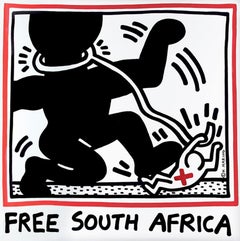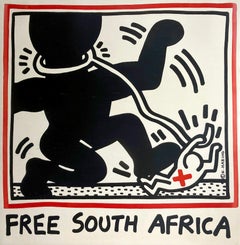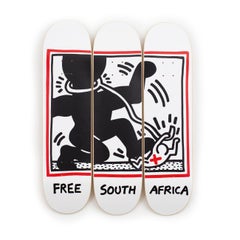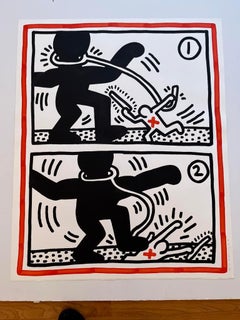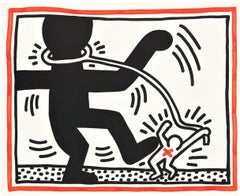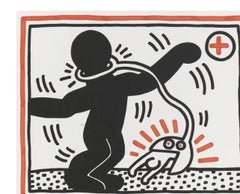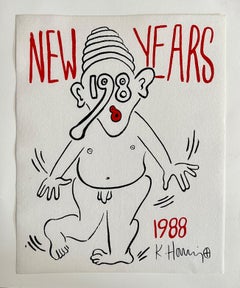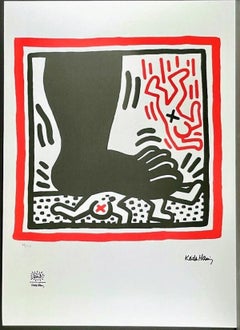Keith Haring Free South Africa
1980s Pop Art Figurative Prints
Lithograph, Offset
1980s Prints and Multiples
Lithograph
20th Century Pop Art Prints and Multiples
Paper, Lithograph
1980s Pop Art Prints and Multiples
Lithograph
2010s More Art
Wood
1980s Pop Art Prints and Multiples
Paper, Lithograph
1980s Pop Art Prints and Multiples
Lithograph
20th Century Pop Art Prints and Multiples
Lithograph
1980s Contemporary More Prints
Lithograph
1980s Street Art More Prints
Lithograph
20th Century Contemporary Nude Prints
Mixed Media, Screen
Recent Sales
1980s Pop Art Figurative Prints
Archival Paper, Lithograph
1980s Pop Art Figurative Prints
Lithograph
1980s Pop Art Figurative Prints
Lithograph
Late 20th Century Mixed Media
Plastic, Permanent Marker
1980s Pop Art Figurative Prints
Lithograph, Offset
1980s Pop Art Figurative Prints
Lithograph, Offset
1980s Pop Art Figurative Prints
Lithograph, Offset
1980s Pop Art Abstract Prints
Offset
1980s Figurative Prints
Offset
20th Century Contemporary Mixed Media
Mixed Media
20th Century Pop Art Prints and Multiples
Lithograph
Lithograph
People Also Browsed
21st Century and Contemporary Modern Black and White Photography
Silver Gelatin
Late 19th Century Impressionist Portrait Paintings
Canvas, Oil
21st Century and Contemporary Swedish Mid-Century Modern Table Lamps
Textile
Vintage 1970s Swiss Mid-Century Modern Sofas
Leather
21st Century and Contemporary Portuguese Modern Benches
Velvet, Wood, Lacquer, Fabric
21st Century and Contemporary Italian Modern Sofas
Leather, Wood
1950s Modern Color Photography
Archival Pigment
Antique 15th Century and Earlier Uruguayan Natural Specimens
Agate, Amethyst, Quartz
20th Century Realist Landscape Paintings
Canvas, Oil
Early 20th Century Art Deco Nude Sculptures
Bronze
Early 2000s American Wallpaper
Paper
1890s Impressionist Figurative Paintings
Canvas, Oil
Late 18th Century English School Landscape Paintings
Oil
1980s Pop Art Portrait Prints
Board, Screen
2010s American Modern Chandeliers and Pendants
Brass
20th Century Surrealist Prints and Multiples
Paper, Etching
Keith Haring Free South Africa For Sale on 1stDibs
How Much is a Keith Haring Free South Africa?
Keith Haring for sale on 1stDibs
Keith Haring began experimenting with his bold, graphic lines and cartoon-inspired figures on the walls of New York City subway stations in the early 1980s. He called them his “laboratory,” places to develop a radical new aesthetic based on an ideology of creating truly democratic public art.
Haring’s paintings, prints and murals address the universal themes of death, love and sex, as well as contemporary issues he experienced personally, like the crack-cocaine and AIDS epidemics. They derive much of their impact from the powerful contrast between these serious subjects and the joyful, vibrant pictographic language he uses to express them, full of dancing figures, babies, barking dogs, hearts and rhythmic lines, as well as references to pop culture.
To make his art even more accessible, in 1986, Haring opened the Pop Shop in Soho. In a foreshadowing of today’s intermingling of art and fashion, the shop sold merchandise and novelty items featuring imagery by Haring and contemporaries like Kenny Scharf and Jean-Michel Basquiat. While his works sometimes included text, for the most part, he chose to communicate through drawing.
“Drawing is still basically the same as it has been since prehistoric times,” Haring once declared. “It lives through magic.”
Find Keith Haring art on 1stDibs today.
Finding the Right Prints And Multiples for You
Decorating with fine art prints — whether they’re figurative prints, abstract prints or another variety — has always been a practical way of bringing a space to life as well as bringing works by an artist you love into your home.
Pursued in the 1960s and ’70s, largely by Pop artists drawn to its associations with mass production, advertising, packaging and seriality, as well as those challenging the primacy of the Abstract Expressionist brushstroke, printmaking was embraced in the 1980s by painters and conceptual artists ranging from David Salle and Elizabeth Murray to Adrian Piper and Sherrie Levine.
Printmaking is the transfer of an image from one surface to another. An artist takes a material like stone, metal, wood or wax, carves, incises, draws or otherwise marks it with an image, inks or paints it and then transfers the image to a piece of paper or other material.
Fine art prints are frequently confused with their more commercial counterparts. After all, our closest connection to the printed image is through mass-produced newspapers, magazines and books, and many people don’t realize that even though prints are editions, they start with an original image created by an artist with the intent of reproducing it in a small batch. Fine art prints are created in strictly limited editions — 20 or 30 or maybe 50 — and are always based on an image created specifically to be made into an edition.
Many people think of revered Dutch artist Rembrandt as a painter but may not know that he was a printmaker as well. His prints have been preserved in time along with the work of other celebrated printmakers such as Pablo Picasso, Salvador Dalí and Andy Warhol. These fine art prints are still highly sought after by collectors.
“It’s another tool in the artist’s toolbox, just like painting or sculpture or anything else that an artist uses in the service of mark making or expressing him- or herself,” says International Fine Print Dealers Association (IFPDA) vice president Betsy Senior, of New York’s Betsy Senior Fine Art, Inc.
Because artist’s editions tend to be more affordable and available than his or her unique works, they’re more accessible and can be a great opportunity to bring a variety of colors, textures and shapes into a space.
For tight corners, select small fine art prints as opposed to the oversized bold piece you’ll hang as a focal point in the dining area. But be careful not to choose something that is too big for your space. And feel free to lean into it if need be — not every work needs picture-hanging hooks. Leaning a larger fine art print against the wall behind a bookcase can add a stylish installation-type dynamic to your living room. (Read more about how to arrange wall art here.)
Find fine art prints for sale on 1stDibs today.
- 1stDibs ExpertMarch 22, 2022Keith Haring became famous largely through people viewing the street art he created in subway stations and other locations in New York City. Throughout the 1980s, he was commissioned to produce art in dozens of cities all over the world and showed his works in solo and group exhibitions. A 1982 show at the Tony Shafrazi Gallery in Soho, New York City, earned rave reviews and greatly contributed to his fame. You'll find a selection of Keith Haring art on 1stDibs.
- What was Keith Haring known for?1 Answer1stDibs ExpertAugust 8, 2024Keith Haring was known for his work as an artist. He began experimenting with his bold, graphic lines and cartoon-inspired figures on the walls of New York City subway stations in the early 1980s. He called these underground places his “laboratory” to develop a radical new aesthetic based on the ideology of creating truly democratic public art. Haring used paintings, prints and murals to address the universal themes of death, love and sex, as well as contemporary issues he experienced personally, like the crack-cocaine and AIDS epidemics. These works derive much of their impact from the powerful contrast between these serious subjects and the joyful, vibrant pictographic language he used to express them, full of dancing figures, babies, barking dogs, hearts and rhythmic lines, as well as references to pop culture. To make his art even more accessible, in 1986, Haring opened the Pop Shop in Soho. In a foreshadowing of today’s intermingling of art and fashion, the shop sold merchandise and novelty items featuring his imagery. Find a collection of Keith Haring art on 1stDibs.
